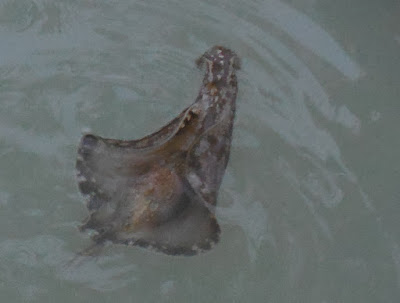Sea Hares
On Mother’s Day in 2016, we saw some marvelous things. There were several of them, these strange
little creatures, moving about gracefully and silently in the water beneath and
around our dock. My husband and I had
never seen anything quite like them.
We’d only been living on Dinkins Bayou for about a year, and before that
we had not lived on salt water. We had
never seen such a weird and beautiful creature that swam like a sting ray, by
flapping its “wings,” which are called parapodia.
The next day, I posted photos of the creatures on Facebook
and asked my knowledgeable friends, “What is this little sea creature?”
 |
| Mottled Sea Hare or Sooty Sea Hare (Aplysia fasciata) in Dinkins Bayou. Sea hares vary in color according to the color of the algae that they eat. |
The answers came quickly:
sea hares, a.k.a. sea slugs. Wildlife
educator Richard Finkel replied, “Sea hares.
They come to shore in spring to deposit their eggs.”
Sea hares are gastropod mollusks; they have a small internal
shell. Off the coast of California, sea
hares are black, and they are significantly larger than our Gulf sea hares.
Sea hares eat algae – nothing but algae – as well as toxic
blue green algae which is not real algae but rather bacteria known as
cyanobacteria. Eating the blue green
algae is a survival mechanism for the sea hares. They eat so much of it that it keeps
predators (mostly crabs and lobsters) at bay. (They also squirt out red or purple ink to
ward off predators.) Scientists found
that a substance called dolestat is in some cyanobacteria. Sea hares that eat cyanobacteria can
concentrate dolestat molecules in their bodies.
That dolestat in sea hares has been used to make a cancer-fighting
immunotherapy drug called Adcetris (brentuximab vedotin).
Julianne Steers, a marine biologist at the Ocean Institute
in California, is an expert on sea hares.
When asked to identify some of the creature’s unique characteristics,
she said, “They are hermaphrodites, meaning they have both male and female
reproductive organs . . . . And, they are a valuable laboratory animal. Medical
researchers use them in neurobiological studies on learning and memory. These
animals have some of the largest neurons in the animal kingdom.”
People often ask if sea hares are edible. The Florida Go Fishing web site recommends
against trying to eat them because of the toxin in the ink that they squirt;
that toxin is also in the sea hare’s slimy skin. Because they are not appetizing and not
abundant, Florida Go Fishing also does not recommend using them for bait, either. And don’t put them in your aquarium, because
after they eat all the algae they will starve.
Florida Go Fishing concludes, “Let’s just say, leave the sea hares alone
and enjoy their beauty as they pass you buy.”
That sounds like good advice to me!
SOURCES:
https://www.ecori.org/narragansett-bay/2020/4/21/algal-blooms-toxic-but-with-possible-drug-potential


Comments
Post a Comment